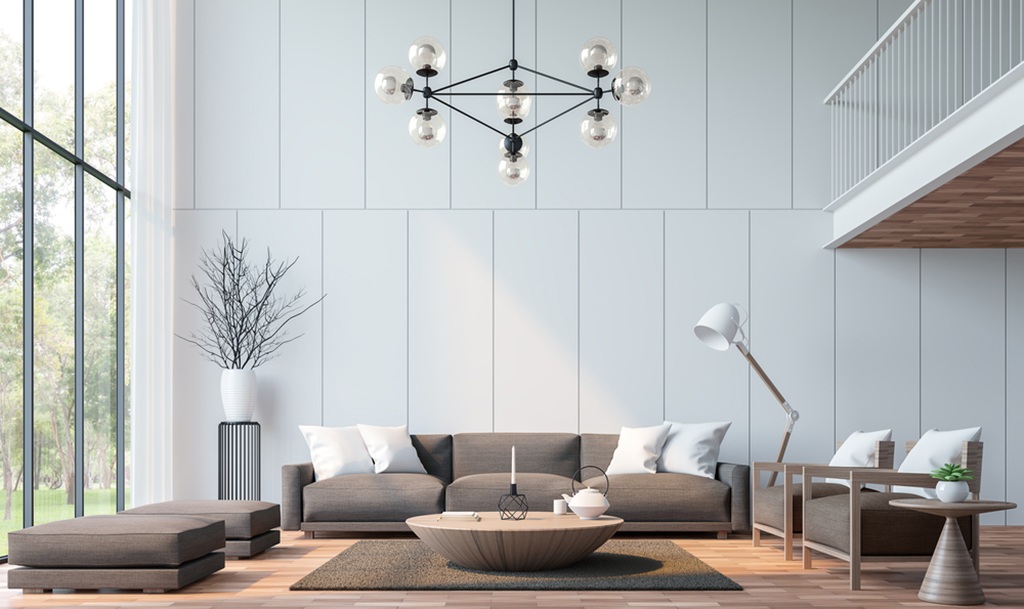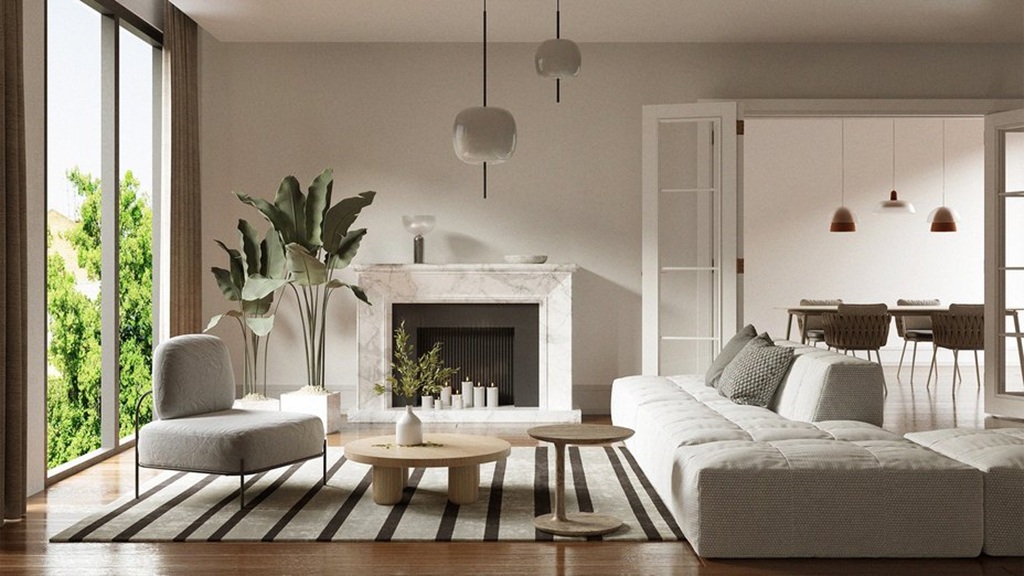
In a world that often feels cluttered and chaotic, the allure of a modern minimalist home is stronger than ever. It’s more than just an aesthetic; it’s a philosophy that champions simplicity, functionality, and intentionality. Creating a modern minimalist haven isn’t about stark emptiness, but about curating a space that is both calming and visually compelling. As we move further into 2025, this enduring style continues to evolve, embracing warmer tones, natural textures, and sustainable choices. This comprehensive guide will walk you through the essential steps to achieve a sophisticated and inviting modern minimalist look in your own home.
The modern minimalist approach is rooted in the idea that “less is more.” Every element in your home should have a purpose, contributing to the overall harmony and functionality of the space. It’s about stripping away the superfluous to highlight clean lines, open spaces, and the inherent beauty of well-chosen materials. This doesn’t mean your home will lack personality; on the contrary, minimalism allows your carefully selected pieces to truly shine, reflecting your individual taste in a deliberate and uncluttered manner. By focusing on quality over quantity and thoughtful design, you can transform your living environment into a sanctuary of peace and refined style.
Foundations of Modern Minimalism: Decluttering and Defining Your Space
The journey to a modern minimalist interior begins not with acquiring new things, but with letting go. This foundational step is crucial and arguably the most transformative.
The Art of Intentional Decluttering: Before you can build your minimalist aesthetic, you must clear the canvas. This means going through your belongings room by room and making honest assessments. Ask yourself: Is this item essential? Does it bring me joy or serve a genuine purpose? Items that don’t meet these criteria should be donated, sold, or responsibly discarded. This process can be challenging, but the reward is a home that feels lighter, more spacious, and easier to manage. Focus on one area at a time to avoid feeling overwhelmed. Consider the “one in, one out” rule moving forward to maintain a clutter-free environment. Remember, the goal isn’t just to have less stuff, but to make space for what truly matters. Digital clutter also counts; organize your digital life for an added sense of clarity that often translates to your physical space.
Maximizing Light and Space: Modern minimalism thrives on open, airy environments. Natural light is a key component, making spaces feel larger and more inviting. Keep window treatments simple – sheer curtains, blinds, or even bare windows if privacy allows. Mirrors can also be strategically placed to reflect light and create an illusion of spaciousness. Consider an open-plan layout if feasible, as it enhances flow and connectivity between rooms. If structural changes aren’t possible, create visual openness by ensuring clear pathways and avoiding oversized furniture that can constrict the area. Think about how light interacts with your space throughout the day and arrange elements to capitalize on this natural asset. Even the color of your light bulbs (aim for natural or warm white) can impact the minimalist feel.
The Modern Minimalist Palette: Colors and Materials for a Serene Atmosphere
Choosing the right colors and materials is fundamental to achieving a modern minimalist look that feels both contemporary and timeless.
Embracing Neutral Tones with Warmth (2025 Trends): While classic minimalism often leaned on stark whites and cool grays, the 2025 iteration sees a shift towards warmer, more inviting neutrals. Think creamy off-whites, soft beiges, muted taupes, and earthy terracotta. These hues create a calming backdrop without feeling cold. A monochromatic scheme within these warm neutrals can be incredibly sophisticated. Don’t be afraid to introduce subtle variations in tone and shade to add depth. Accent colors should be used sparingly but purposefully. Consider muted greens, soft blues, or even a carefully placed touch of a bolder, desaturated color like burnt orange or deep jewel tones, but ensure they complement the overall serene feel rather than overwhelm it. The 60-30-10 rule can be a helpful guideline: 60% dominant neutral, 30% secondary neutral or texture, and 10% subtle accent.
The Importance of Texture and Natural Materials: To prevent a minimalist space from feeling flat or sterile, texture is paramount. Incorporate a variety of natural materials to add visual interest and tactile warmth. Think light-toned woods like oak or maple for flooring and furniture, linen or cotton for upholstery and curtains, wool for rugs and throws, and stone or ceramic for accents. Smooth concrete or polished plaster can also provide a sleek, modern textural element. The interplay of different textures – a smooth wooden table against a nubby wool rug, for example – creates a rich, layered look that is still fundamentally minimalist. Consider textured wall finishes like limewash or subtle plaster effects, a growing trend that adds depth and character without clutter. Biophilic design principles, which involve connecting with nature, also encourage the use of these organic materials and the inclusion of indoor plants.
Furnishing with Intent: Functionality Meets Aesthetics
In a minimalist home, furniture is not just functional; it’s a statement of intent. Each piece should be carefully chosen for its form, purpose, and contribution to the overall design.
Selecting Clean-Lined and Multi-Functional Furniture: Opt for furniture with simple silhouettes, clean lines, and a clear purpose. Avoid overly ornate or heavily detailed pieces. Look for items that are not only aesthetically pleasing but also offer smart solutions. Multi-functional furniture is a cornerstone of minimalist design, especially in smaller spaces. An ottoman with hidden storage, a sofa bed, a console table that can double as a desk, or modular shelving units are all excellent choices. Quality craftsmanship is crucial; since you’ll have fewer pieces, invest in well-made items that will stand the test of time. Consider the scale of your furniture in relation to the room – pieces should be proportionate and not overcrowd the space.
Strategic Placement and Negative Space: How you arrange your furniture is just as important as the pieces themselves. Embrace negative space – the empty areas around and between furniture. This “breathing room” is essential to the minimalist aesthetic, preventing the space from feeling cramped and allowing each piece to be appreciated. Ensure clear pathways and a logical flow through the room. Group furniture to create defined zones for different activities, such as a seating area for conversation or a quiet corner for reading. The goal is to create a layout that is both functional and visually balanced. Avoid pushing all furniture against the walls; pulling pieces away can often make a room feel larger and more thoughtfully arranged.
Related: Sleep Haven Makeover: Elevate Your Bedroom Aesthetic!
Decor and Accessories: The Art of “Less is More”

In modern minimalism, decor is used sparingly but with great impact. It’s about thoughtful curation rather than accumulation.
Intentional Decoration – Quality Over Quantity: Every decorative item should have a reason for being there. Choose a few high-quality pieces that you truly love and that enhance the overall aesthetic. This could be a single striking piece of art on a wall, a beautifully crafted vase, or a few carefully selected books. Avoid cluttering surfaces with numerous small trinkets. The idea is to create focal points that draw the eye without overwhelming the senses. Consider the visual weight of each object and how it interacts with the surrounding space and other elements.
Incorporating Greenery and Natural Elements: Plants are a fantastic way to add life, color, and a touch of nature to a minimalist interior. Choose plants with interesting leaf shapes or sculptural qualities. A single large potted plant can make a significant statement, or a small collection of succulents can add subtle interest. Beyond plants, other natural elements like a bowl of smooth stones, a piece of driftwood, or a simple branch in a vase can also enhance the serene, organic feel of the space. These elements bring texture and a connection to the outdoors, aligning with the 2025 trend of biophilic design.
Lighting: Setting the Mood
Lighting plays a critical role in shaping the ambiance of a minimalist home. It’s not just about illumination; it’s about creating atmosphere and highlighting architectural features and chosen decor.
Layering Light Sources: Relying on a single overhead light can make a space feel flat and uninviting. Instead, layer your lighting with a combination of ambient, task, and accent lighting.
- Ambient Lighting: This provides overall illumination and includes ceiling fixtures like recessed lights, flush mounts, or minimalist pendant lights.
- Task Lighting: This is focused light for specific activities, such as under-cabinet lights in the kitchen, a floor lamp beside a reading chair, or a desk lamp in a home office.
- Accent Lighting: This draws attention to specific features, like artwork, architectural details, or plants. Track lighting or spotlights can be used for this purpose. Opt for fixtures with simple, clean designs that complement the minimalist aesthetic. Dimmers are also a valuable addition, allowing you to control the intensity and mood of the lighting throughout the day.
Related: Cheap Home Decor Ideas for a Modern Look: A Comprehensive Guide
Maintaining Your Modern Minimalist Home
Achieving a minimalist look is one thing; maintaining it requires ongoing effort and mindfulness.
Cultivating Mindful Habits: Once you’ve decluttered and designed your minimalist space, cultivate habits that prevent clutter from creeping back in. Practice the “one in, one out” rule for new purchases. Be mindful of what you bring into your home and regularly reassess your belongings. Tidy up daily, putting things back in their designated places. This consistent effort will ensure your home remains a calming and uncluttered sanctuary.
The Beauty of Imperfection (Wabi-Sabi Influence): While minimalism often emphasizes clean lines and order, there’s also room for a touch of “wabi-sabi” – the Japanese concept of finding beauty in imperfection. This can mean embracing the natural aging of materials, a slightly askew throw blanket, or a handcrafted ceramic piece with unique irregularities. This adds a layer of warmth and humanity to the minimalist aesthetic, preventing it from feeling too rigid or clinical.
Creating a modern minimalist home is a rewarding process that can lead to a more peaceful, organized, and intentional way of living. By focusing on decluttering, embracing a warm neutral palette, choosing functional and beautiful furniture, decorating with intent, and layering lighting effectively, you can craft a space that is not only stylish and contemporary but also a true reflection of your personal sanctuary. As trends evolve towards warmer, more textured, and sustainable interpretations of minimalism in 2025, there’s never been a better time to embrace this enduring and transformative design philosophy.
People Also Ask FAQs
Q1: What is the core principle of modern minimalist design?
A1: The core principle of modern minimalist design is “less is more.” It emphasizes simplicity, functionality, and intentionality, stripping away unnecessary elements to create clean, uncluttered, and calming spaces where every item has a purpose and contributes to the overall aesthetic harmony.
Q2: What are the best colors for a modern minimalist home in 2025?
A2: For 2025, modern minimalist homes are embracing warm neutrals like creamy off-whites, soft beiges, muted taupes, and earthy terracottas. While classic grays and whites are still relevant, the trend is towards creating a more inviting and less stark atmosphere. Subtle accent colors like muted greens, soft blues, or a desaturated burnt orange can be used sparingly.
Q3: How can I make my minimalist home feel cozy and not cold?
A3: To make a minimalist home feel cozy, focus on incorporating a variety of textures (wood, linen, wool, stone), using a warmer neutral color palette, layering lighting effectively with dimmers, and adding natural elements like plants. Well-chosen, comfortable furniture and perhaps a few meaningful, high-quality decorative pieces will also add warmth and personality without creating clutter.
Q4: What kind of furniture should I choose for a modern minimalist living room?
A4: Select furniture with clean lines, simple silhouettes, and a clear function. Multi-functional pieces (e.g., an ottoman with storage) are ideal. Opt for quality craftsmanship and natural materials like wood, metal, and linen or cotton upholstery. Ensure the furniture is proportionate to the room size and allows for plenty of negative space.
Q5: How do I declutter effectively for a minimalist home?
A5: Declutter room by room. For each item, ask if it’s essential, functional, or brings you joy. Be honest and let go of items that don’t serve a purpose. Adopt a “one in, one out” rule for new purchases. Focus on creating clear surfaces and ample storage solutions (preferably hidden) to maintain a clutter-free environment.
Q6: Is modern minimalism expensive to achieve?
A6: Not necessarily. While investing in high-quality, durable pieces is encouraged (which can sometimes be more expensive upfront), the focus on having fewer items can actually save money in the long run. You can also find affordable minimalist pieces or even DIY some elements. The key is intentionality and thoughtful purchasing, rather than accumulating many cheap items.
Q7: Can a minimalist home still have personality?
A7: Absolutely! Minimalism allows your chosen pieces to truly shine. Personality is expressed through carefully selected artwork, unique furniture finds, meaningful objects, and the way you combine textures and subtle colors. It’s about a curated personality rather than an overwhelming display of possessions.
Q8: What are some common mistakes to avoid in modern minimalist design?
A8: Common mistakes include: * Making it too stark or cold by overusing cool colors and lacking texture. * Not enough or poor quality lighting. * Choosing furniture that is out of scale with the room. * Keeping too many sentimental items that create clutter (find a balance). * Lack of storage, leading to visible clutter. * Forgetting to add personal touches, making the space feel impersonal.
Related: How to Refurb Your Kitchen on a Budget
Conclusion: Embracing a Lifestyle of Intentional Simplicity
Adopting a modern minimalist look in your home is far more than a fleeting design trend; it’s an invitation to a more intentional, serene, and focused way of life. By consciously choosing to surround yourself with only those things that are beautiful, functional, or deeply meaningful, you create not just a visually appealing space, but a sanctuary that supports your well-being. The journey, from decluttering to carefully selecting each element, is a reflective process that can bring clarity and peace.
As we’ve explored, the modern minimalism of 2025 embraces warmth, texture, and a deeper connection with natural materials, making it more accessible and inviting than ever. It’s about striking the perfect balance between simplicity and soul, creating rooms that breathe and allow your personality to subtly unfold. Remember that your home is a personal haven; the principles of minimalism are guidelines, not rigid rules. Adapt them to suit your lifestyle and preferences, and enjoy the profound satisfaction that comes from a thoughtfully curated, clutter-free environment. Ultimately, a modern minimalist home offers a timeless elegance and a quiet backdrop for a life lived with greater purpose and joy.



